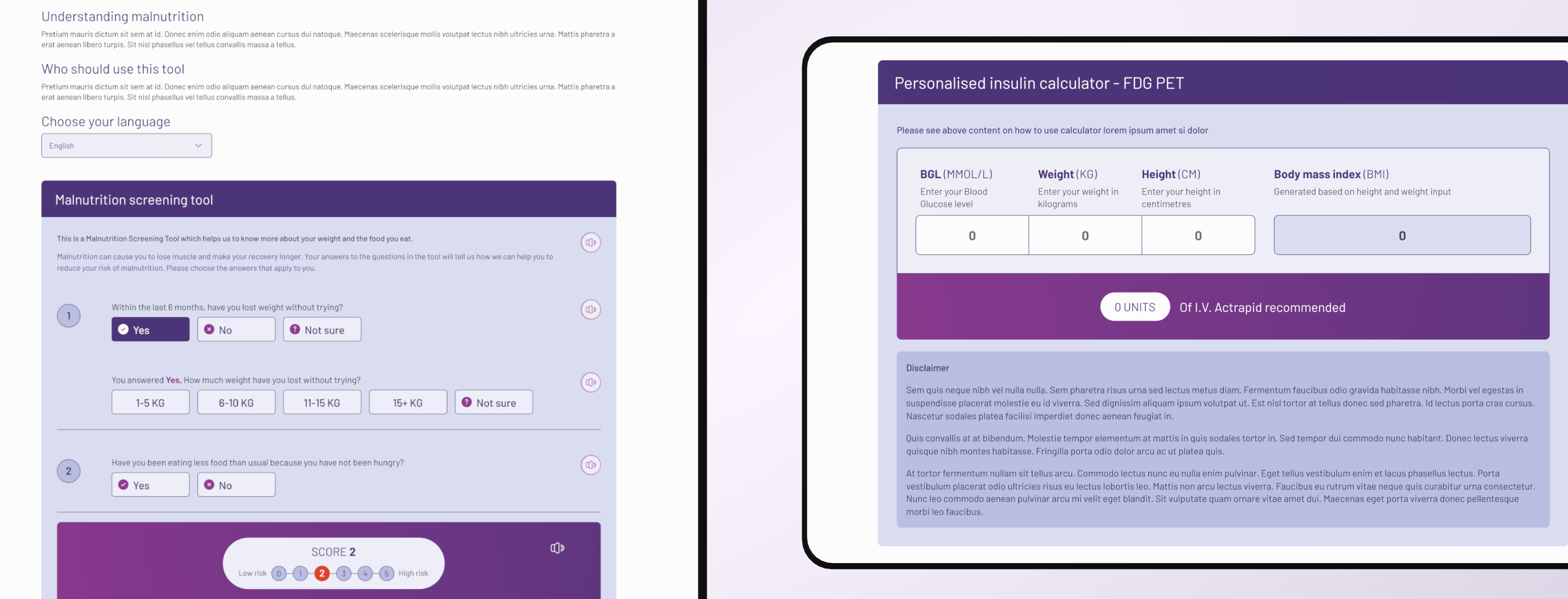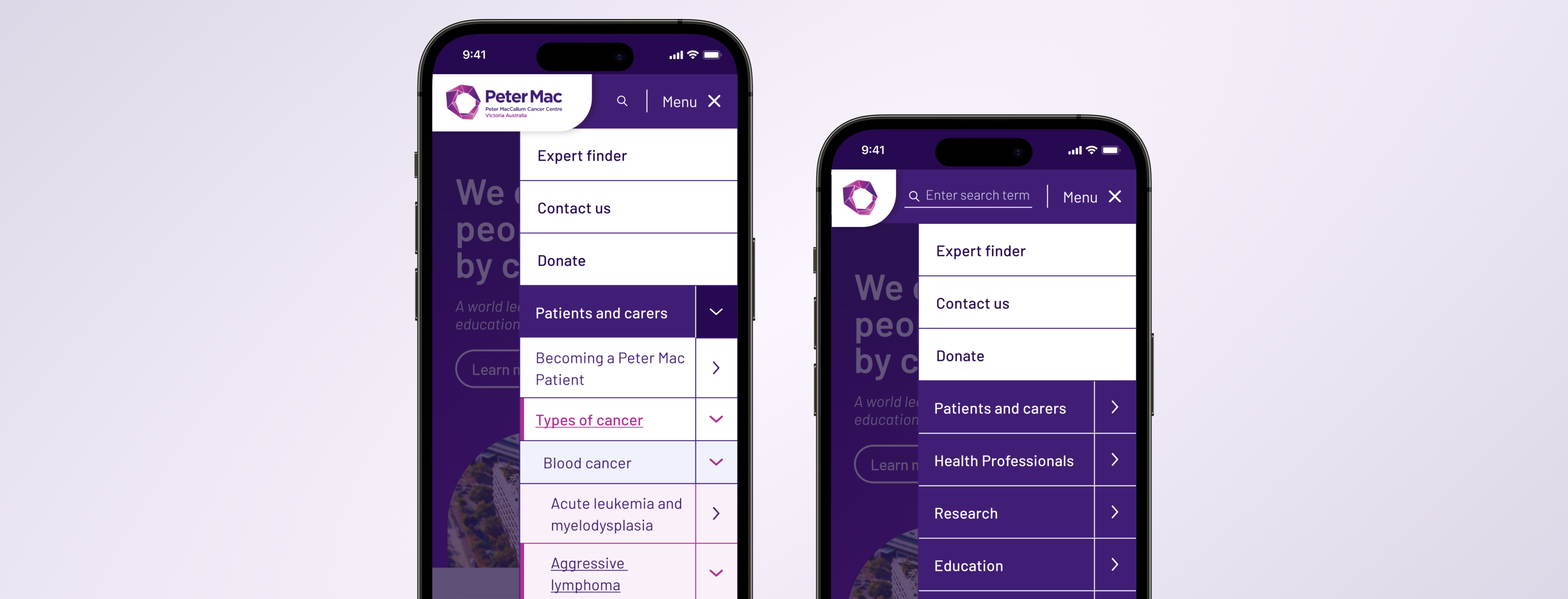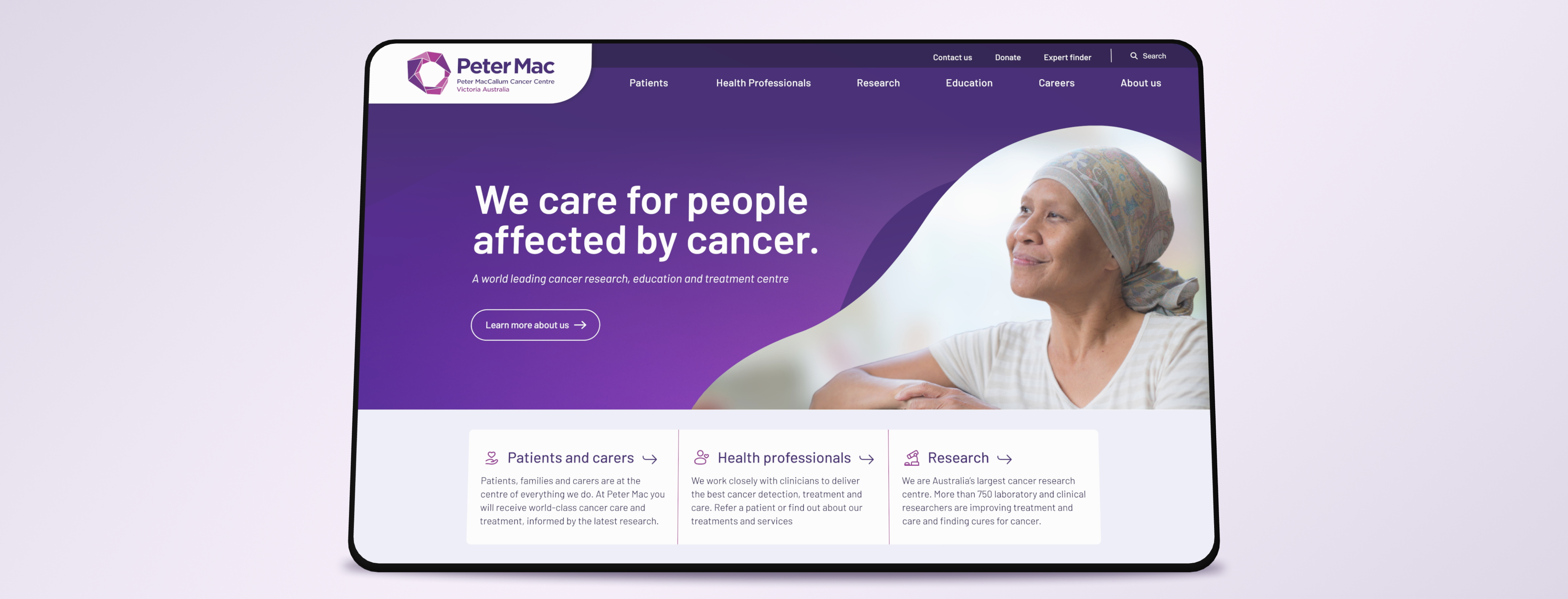the client
Peter MacCallum Cancer Centre (Peter Mac) is a world-leading cancer research, treatment, and education institution based in Melbourne, Australia. The centre is dedicated to providing the best possible care for cancer patients while conducting innovative research to find better ways to prevent, diagnose, and treat cancer. Peter Mac’s website is a valuable resource for patients, families, healthcare professionals, and researchers seeking information about the centre’s services, programs, and research.
The Peter Mac website provides a comprehensive overview of the centre’s clinical services, including information on the various cancer types that the centre specialises in treating, such as breast cancer, lung cancer, and melanoma. Patients can access information on the different treatment options available, including chemotherapy, radiation therapy, surgery, and clinical trials. The website also includes information on support services available to patients, such as counselling, patient and family support, and complementary therapies.
In addition to its clinical services, the website showcases Peter Mac’s research programs, including basic, translational, and clinical research. The centre’s research is focused on discovering new treatments for cancer, understanding the genetic and molecular mechanisms that drive cancer growth, and developing personalised treatment plans for individual patients. The website also provides information on the centre’s educational programs, including training and professional development opportunities for healthcare professionals and community education programs for patients and families. The Peter Mac website is an essential resource for anyone seeking information about cancer care, research, and education in Australia.

the vision
The vision for the new website project was to build a world-class digital platform that would empower Peter Mac to showcase its work, seamlessly connect with patients and healthcare professionals, and improve patient outcomes by enhancing access to care. By creating a robust and expandable platform aligned with Peter Mac’s strategic direction, we aimed to amplify its impact on cancer care and landmark cancer research globally.
To support this vision, the team ensured that the website’s design and functionality were in line with the overall goal. We utilised Joomla 4 as the foundation, providing a solid base for future integrations with other platforms, effectively future-proofing the site. By establishing a consistent look and feel between the Peter Mac and Foundation sites, the team enhanced visual and strategic alignment. Additionally, the transition between the sites was made secure and seamless for the users. Through a collaborative design process involving the client and Butterfly, the team struck a balance between user experience and business objectives.
Key features and functionalities were prioritised based on their ability to contribute to the project’s vision. The site was designed and developed for WCAG 2.1 AA compliance, ensuring accessibility for all users. Thoughtful information architecture (IA) directed key users to find the information they needed quickly. The design of the website was warm, friendly, and approachable, aiming to provide a human and compassionate experience for users throughout their cancer journey. The implementation of an “expert finder” functionality allowed users to navigate the site and connect with experts at Peter Mac. Furthermore, Elasticsearch was utilised to enable users to find relevant results based on their search queries.
User research and feedback played a crucial role in aligning the website’s design and features with the project’s vision and meeting user needs. The team conducted a thorough discovery phase before the project to ensure that the solution was fit for purpose. Multiple workshops were held with internal client stakeholders to involve the entire organisation in the decision-making process. Research activities included competitor analysis, heuristic analysis, stakeholder interviews, user journey mapping, defining personas, stakeholder analysis, customer survey reviews, and information architecture (IA) development.
The team faced some key challenges and roadblocks in realising the project’s vision. Refining certain processes on the client-side, such as the patient referral process, was necessary before implementing certain features on the site. Additionally, some aspects of the project’s scope had to be phased for future development in order to align with the client’s budget and timeline constraints. However, these challenges were overcome through effective communication, collaboration, and prioritisation.

the process
The development process for the new website involved several stages, starting from the initial planning phases and culminating in the final launch. The team followed a structured approach to ensure a smooth and efficient workflow.
The process began with a discovery phase, which involved gathering requirements and understanding the project’s goals. Workshops were conducted to facilitate collaboration and gain insights from internal client stakeholders. Roadmapping and research/analysis activities, including competitor analysis and user journey mapping, further shaped the project’s direction. Information architecture (IA) workshops were conducted to establish a solid foundation for the website’s structure.
Once the project was planned, a timeline was established, and resources were scheduled accordingly. Jira, a project management tool, was utilised to create and manage tasks. The UX design phase involved collaborative design workshops, wireframing, and the creation of design concepts. Regular meetings, including weekly work-in-progress meetings with the client and sprint planning meetings with the Butterfly project team, ensured effective communication and progress tracking.
The development phase encompassed backend and frontend development, with a focus on maintaining high-quality code and adherence to industry standards. Quality assurance testing played a vital role in ensuring the website was bug-free before launch. The QA team was involved in backlog meetings from the start to provide context and used Testrail to capture test cases and test runs. Close communication between the QA team and software engineers facilitated the resolution of any issues during the QA process.
To ensure the website met industry best practices and standards, the team took several measures. The site was designed and developed to comply with WCAG 2.1 AA accessibility guidelines. Penetration testing, conducted by the client’s vendor, identified security concerns that were promptly addressed by the Butterfly team. Cloudflare and AWS hosting were utilised to enhance performance and security, including load balancing and scaling capabilities. Regular backups, a 99.9% uptime guarantee, SSL certificate implementation, and web application security measures were put in place to safeguard the website.
Throughout the process, tools such as Jira, Teamwork, Slack, Google Meets, and Figma were employed to streamline collaboration among team members. Scrum practices, including backlog refinement, sprint planning, and retrospective meetings, ensured effective project management and continuous improvement.
The team’s meticulous approach to development, quality assurance, and adherence to industry standards played a crucial role in delivering a high-quality website that met the project’s goals and requirements.

the outcome
The primary goals and objectives for the new website project were successfully achieved, exceeding expectations and garnering positive feedback from users and stakeholders.
The website delivers clearly targeted information to all users, thanks to the thoughtful information architecture (IA) and defined user journeys. Users can easily find the information they are seeking, enhancing their experience on the site.
The website effectively represents the Peter Mac brand as a global leader in cancer treatment, care, research, and education. The fresh, modern, and well-designed websites instil confidence in the Peter Mac brand, positioning it with authority and credibility.
The website enables broader digital capability across Peter Mac, facilitating improved processes. The scalable Joomla 4 CMS provides a platform for continuous development and the inclusion of new features, empowering Peter Mac to constantly improve and enhance its processes.
Through close collaboration with the client, future phase items have been identified and captured throughout the project, ensuring ongoing improvements and additions to meet evolving needs.
The website demonstrates a deep and insightful understanding of users’ needs, delivering on their requirements. The WCAG 2.1 AA compliance, coupled with the thoughtful IA and clear user journeys, ensures that users can easily find the information they are seeking and have a seamless experience.
Feedback from users and stakeholders has been overwhelmingly positive. With the launch of the new sites, Peter Mac and the foundation are now looking at multiple future phases to introduce additional features and improvements. The stakeholders are invested in updating and enhancing the content on the new site, further demonstrating the success and impact of the website project.





